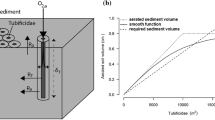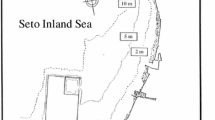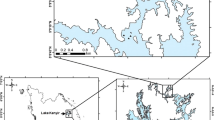Abstract
Importance of tubificid populations on nitrogen cycle in two categories of shallow eutrophic lakes in the Danube Delta was quantitatively assessed for the 1992-1993 period. The structure of the primary producers in the studied lakes was used to discriminate between the two categories:(i) lakes dominated by macrophytes (A1) and (ii) lakes dominated by phytoplankton (A2). In both categories tubificid worms represented important fraction of the entire benthic community (35 and 32%, respectively, as number of individuals). They influence the sediment-water exchange of nutrients. The main processes involved are excretion of nutrients and their continuous release from sediments by molecular diffusion or through channels created by bioturbation. Inorganic nitrogen released from bottom sediments may regulate nitrogen load in the water body and thus, phytoplankton production. In 1992-1993, nitrogen stocks in tubificid biomass accounted for 5.3% in A1 lakes and 15.6% in A2 lakes of the amount stocked in phytoplankton, and only for 1.2 and 2.9% respectively, of the nitrogen load in water body. Nitrogen excretion rates ranged between 60.52 and 153.74 mg N m−2 year−1, and release rates from sediments between 378.26 and 960.87 mg N m−2 year−1, the lowest values being recorded for A2 category. Differences are related to tubificid biomass, structure and abundance of primary producers and to nutrient load in different ecosystems. Ratios between release rate of inorganic nitrogen by tubificid worms and sedimentation rate of organic nitrogen in the two categories of lakes were 8.3 and 6.4% respectively. Contribution of nitrogen released daily from sediments to the dissolved inorganic nitrogen load in the water column was less than 0.5%. However, in A1 and A2 lakes, the released nitrogen had a potential to sustain 24.74 and 8.01%, respectively, of the annual phytoplankton production. These values suggest the significance of tubificids in keeping the eutrophication process at a high level, especially during the periods when nitrogen is the main limiting factor for phytoplankton production.
Similar content being viewed by others
References
Botnariuc, N., G. Ignat, I. Diaconu & A. Vãdineanu, 1987. L' évolution de l'é tat trophique des écosystémes aquatiques caractéristiques au Delta du Danube: 5. La structure et la dynamique de la faune benthonique. Revue Roumaine de Biologie-Biologie Animale 32: 121-127.
Bremner, JM., 1965. Inorganic forms of nitrogen. In Black, C. A. et al. (eds), Methods of Soil Analysis. American Society of Argon, Inc., Madison, WI: 1179-1237.
Claesson, A. & S. O. Ryding, 1977. Nitrogen-a growth limiting nutrient in eutrophic lakes. Progresses in Water Technology 8: 291-199.
Cristofor, S., 1987. L' évolution de l'état trophique des écosystémes aquatiques caractéristiques au Delta du Danube: 6. Réssponses de la végétation submerse en fonction de la ré serve de nutrients et du ré gime hidrologique. Revue Roumaine de Biologie-Biologie Animale 32: 129-138.
Cristofor, S., A. Vadineanu & G. Ignat, 1993. Importance of flood zones for nitrogen and phosphorus dynamic in the Danube Delta. Hydrobiologia 251: 143-148.
Davis R. B., D. L. Thurlow & F. E. Brewster, 1975. Effects of burrowing tubificid worms on the exchange of phosphorus between lake sediment and overlying water. Verhandlungen. Proceedings of International Association of Theoretical and Applied Limnology 19: 382-394.
Devine J. A. & M. J. Vanni, 2002. Spatial and seasonal variation in nutrient excretion by benthic invertebrates in a eutrophic reservoir. Freshwater Biology 47: 1107-1121.
Fukuhara, H. & M. Sakamoto, 1987. Enhancement of inorganic nitrogen and phosphate release from lake sediment by tubificid worms and chironomid larvae. Oikos 48: 312-320.
Fukuhara, H. & M. Sakamoto, 1988. Ecological significance of bioturbation of zoobenthos community in nitrogen release from bottom sediments in a shallow eutrophic lake. Archiv für Hydrobiolgie 113: 425-445.
Fukuhara, H. & K. Yasuda, 1989. Ammonium excretion by some freshwater zoobenthos from an eutrophic lake. Hydrobiologia 173: 1-8.
Gardner, W. S., T. F. Nalepa, D.S. Slavenus & G. A. Laird, 1983. Patterns and rates of nitrogen release by benthic Chironomidae and Oligochaeta. Canadian Journal of Fisheries and Aquatic Sciences 40: 259-266.
Gâtescu, P., 1993. The Danube Delta: geographical characteristics and ecological recovery. Geo Journal 29: 57-67.
Golterman, H. L. (ed.), 1977. Interactions between Sediments and Freshwater. Dr W. Junk Publishers, The Hague.
Hamilton, L. A., 1969. On estimating annual production. Reprinted from Limnology and Oceanography 14: 771-782.
Kempers A. J., 1974. Determination of sub-microquantities of ammonium and nitrates in soil with phenol, sodium nitroprusside and hipochlorite. Geoderma 12: 201-206.
Risnoveanu, G. & A. Vãdineanu, 2000. Evaluarea rolului asociatiilor si populatiilor in functionarea sistemelor ecologice. Studiu de caz: oligochetele bentonice din Dunarea inferioara si Delta Dunarii. Ars-Docendi, Bucharest.
Risnoveanu, G., G. Ignat, A. Vãdineanu, S. Cristofor, C. Ciubuc, G. Nãfornitã& M. Popescu, 1997. The state of the benthic community of the Danube Delta lakes-a consequence of eutrophication. Revue Roumaine de Biologie-Biologie Animale 42: 227-235.
Risnoveanu, G., C. Postolache & A. Vãdineanu, 2001. Nitrogen and phosphorous excretion rates by Tubificids from the Danube River. In Weber, J. et al. (eds), Biogeochemical Processes and Cycling of Elements in the Environment. Wroclaw, Poland: 205-206.
Risnoveanu, G., A. Vãdineanu & G. Ignat, 1998. The structure of the benthic oligochaeta communities in the Danube Delta lakes. Revue Roumaine de Biologie-Biologie Animale 44: 1-12.
Sakamoto, M., H. Hayashi, A. Otsiki, K. Aoyama, Y. Watanabe, T. Hanazato, T. Iwakuma & M. Yasuno, 1989. Role of bottom sediments in sustaining plankton production in a lake ecosystem. Experimental demonstration using enclosed water bodies in a shallow eutrophic lake. Ecological Research 4: 1-16.
Sârbu, A., 1997. Rolul macrofitelor submerse in circuitul unor elemente minerale in ecosiâstemele acvatice din Delta Dunãrii. Ph.D. Thesis, University of Bucharest.
Tá;trai, I., 1987. The role of fish and benthos in the nitrogen budget of Lake Balaton, Hungary. Archiv für Hydrobiolgie 110: 291-302.
Vãdineanu, A. & S. Cristofor,1987. L'evolution de l'etat trophique des ecosystems aquatiques caracteristiques du Delta du Danube. 1. Le regime hidrologique, transparence Secchi et la reserve de phosphore et d'azote. Revue Roumaine de Biologie-Biologie Animale 32: 83-91.
Vãdineanu, A., Hiel'ekueta, S. Cristofor & I. Rugea, 1985. Consideratii asupra dinamicii carbonului organic particulat in unele ecosisteme acvatice ale Deltei Dunarii. Delta Dunarii-Studii si comunicari de ecologie, Tulcea: 155-167.
Vãdineanu, A., N. Botnariuc, S. Cristofor, G. Ignat & C. Dorobantu, 1989. Tranzitii ale starii trofice a ecosistemelor acvatice din Delta Dunãrii în perioada 1981-1987. Ocrotirea Naturii si Mediului Inconjurator 33: 27-34.
Vãdineanu, A., S. Cristofor, G. Ignat, C. Ciubuc, G. Risnoveanu, F. Bodescu & N. Botnariuc, 2002. Structural and functional changes within the benthic communities from Danube Delta Lakes, Verhandlungen. Proceedings of International Association of Theoretical and Applied Limnology 27: 2571-2576.
Vollenweider, R. A., 1969. Sampling techniques and methods for estimating quantity and quality of phytoplankton. In Vollenweider, R. A., J. F. Talling & D. F. Westlake (eds), A Manual on Methods for Measuring Primary Production in Aquatic Environments Including a Chapter on Bacteria. Blackwell Scientific Publishers, Oxford: 4-40.
Whigham, D. F., C. Chitterling & B. Palmer, 1988. Impacts of freshwater wetlands on water quality: a landscape perspective. Environmental Management 12: 663-671.
Author information
Authors and Affiliations
Rights and permissions
About this article
Cite this article
Geta, R., Postolache, C. & Vădineanu, A. Ecological Significance of Nitrogen Cycling by Tubificid Communities in Shallow Eutrophic Lakes of the Danube Delta. Hydrobiologia 524, 193–202 (2004). https://doi.org/10.1023/B:HYDR.0000036133.92034.69
Issue Date:
DOI: https://doi.org/10.1023/B:HYDR.0000036133.92034.69




